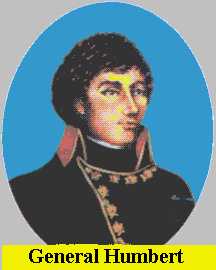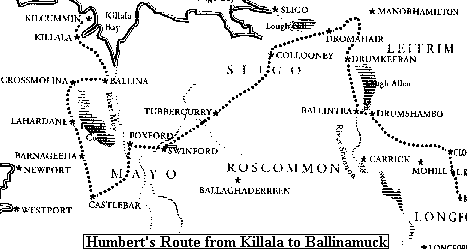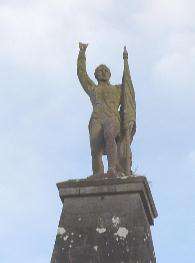LIEUTENANT TEELING AT CARRICKNAGAT

Teeling Statue at Carricknagat

On 22nd August 1798 General Humbert and a French force of 1099 officers and men landed at Killala. After Humbert had captured Castlebar on 27th August, many Irish flocked to his standard. Threatened by an English counter-attack, Humbert evacuated Castlebar on 3rd/4th September and in 36 hours his force, now totalling 3000 men, marched 58 miles to Collooney.

Colonel Verecker was in charge of the garrison in Sligo, and he came with his yeomanry and militia to confront the French/Irish force. They met at Carricknagat [just outside Collooney]on 5th September. In Archdeacon O'Rorke's account of the battle in his history of the parish a decisive part was played by Bartholomew Teeling, an aide-de-camp to Humbert. He succeeded in silencing a gun which had been placed on a hill to the west of the field of battle, and which was commanded by an able gunner called Whitters.
"Little more than twenty years of age, tall, handsome - a very Mars in military bearing - Teeling was the most conspicuous figure on the field as he dashed about on a "gallant grey" with the orders of the general. This chivalrous soul chafed with indignation and impatience on observing the faltering of some in the presence of Whitters' cannon, and resolved to remove the cause of their anxiety or perish in the attempt. "Accordingly he struck away towards the centre of the open field, and, setting spurs to horse, galloped straight to the mouth of the gun. There was a solemn pause, and every eye in the two armies was upon the horseman as he pulled up the fiery grey. On the momentTeeling raised his pistol as coolly as if on parade, took steady aim and shot the formidable Whitters behind his cannon. In the twinkling of an eye the intrepid youth was returning, and though hundreds of muskets were discharged, he and his horse, passed through the shower of bullets unharmed back to the French, who received the
hero with a shout of enthusiastic welcome.
"This was the turning point of the battle. The troops despatched from Knockbeg had reached Beal Ban and were already rushing down on the British flank. The other column was advancing at a rapid pace against the front. There was no safety for Verecker from this double danger except in retreat; and as the Ballysadare road was no longer practicable, he ordered his men to cross the river and make for Sligo." (O'Rorke)

Though he won the day at Carricknagat Humbert abandoned his intention of marching northwards to join forces with insurgents in Donegal, and instead he headed for the midlands. On 8th September 850 French soldiers and 1500 rebels met the Crown forces at Ballinamuck in Co. Longford. After a brief engagement with the superior force Humbert surrendered.
Lieutenant Teeling escaped after the battle but he was eventually captured and hanged at Arbour Hill prison in Dublin. His name is remembered in streets in Sligo and Ballymote, and on the centenary in 1898 a fine memorial was erected at Carricknagat. He deserves our kind remembrance.
Back to home page




